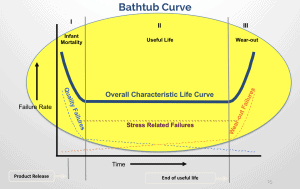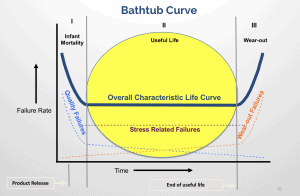
There are a few ways to demonstrate statistical confidence in reliability of a design. Each has it reasons for selection. here are three of my favorites
Binomial Testing: Best used for comparison of two populations. The resulting statement would be confidence in if the two populations are similar more than the likelihood two random populations are similar. It does not permit you to make a confidence statement against set values in it’s base form.
Binomial Success Testing: This is a very efficient and simple way to make a statement of confidence if a design can achieve a specified reliability goal. The disadvantages to this are that all units have to be run to full life and there is no differentiation with regard to what failure types have occurred. It simulates the customers perspective, “I failed, doesn’t matter to me that it was a quality, random or premature wear-out failure, I just want my money back.”
Chi square: Using the Chi square distribution to make a confidence statement is beneficial when you are interested in a statement of a specific type of failure mode, Infant mortality, random, or wear-out. In addition this method let’s you make continuous statements on confidence as the test progresses. This can be very helpful in programs where decision gates exist that require reliability input, “Are we on the projected path to hit our 80% confidence in the reliability goal at release.”
-Adam


 Ask a question or send along a comment.
Please login to view and use the contact form.
Ask a question or send along a comment.
Please login to view and use the contact form.
Leave a Reply